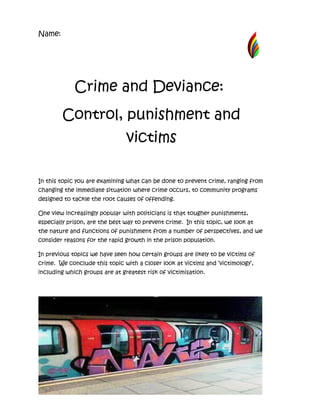
Crime and Deviance: Control, punishment and victims
- 1. Name: Crime and Deviance: Control, punishment and victims In this topic you are examining what can be done to prevent crime, ranging from changing the immediate situation where crime occurs, to community programs designed to tackle the root causes of offending. One view increasingly popular with politicians is that tougher punishments, especially prison, are the best way to prevent crime. In this topic, we look at the nature and functions of punishment from a number of perspectives, and we consider reasons for the rapid growth in the prison population. In previous topics we have seen how certain groups are likely to be victims of crime. We conclude this topic with a closer look at victims and ‘victimology’, including which groups are at greatest risk of victimisation.
- 2. Learning objectives: After studying this topic you should: • Understand and be able to evaluate a range of crime prevention and control strategies; • Understand and be able to evaluate different perspectives on punishment; • Know the main trends in sentencing and understand their significance; • Know the main patterns of victimisation and be able to evaluate sociological perspectives on victimisation. Key questions: Key information 1. How can we prevent crime from • Crime prevention policies happening? – ‘broken window’; 2. Does our way of punishing really • Punishment of crimes and the prison system; work? • Victimology – the study of 3. What can we learn from victims of victims; crime? • The role of the Criminal 4. What is the role of the criminal Justice system. justice system?
- 7. What makes people conform? And when they are tempted not to do so, what can be done to prevent them deviating? These questions raise the issue of social control – the capacities of societies to regulate their members’ behaviour – and crime prevention. This section examines different approaches to these questions. Task: What prevention methods (i) do you take personally to avoid being a victim of crime in different situations; (ii) are taken in the family home; (iii) have you seen elsewhere (eg school/ college, shops, transport) in the last few days?
- 8. Crime prevention and control 1. Using the glossary at the back of the textbook explain what is meant by ‘situational crime prevention’. 2. Summarise the ideas of Ron Clarke (1992) and Marcus Felson (1998).
- 9. 3. Read the section ‘Displacement’ and ‘Evaluation’. Explain, with examples, criticisms of situational crime prevention. 4. What is meant by ‘zero tolerance policing’? 5. What did Wilson and Kelling (1992) mean in their article ‘broken windows’? What problems might arise if their zero tolerance policy is introduced into a neighbourhood?
- 10. The Perry pre-school project and crime prevention The High/Scope Perry Preschool Project is a famous research study started in 1962 by David Weikart in Michigan, USA. The project provided high-quality pre- school education to three- and four-year-old African-American children living in poverty and assessed to be at high risk of school failure. The 123 children involved were divided randomly into two groups. Fifty-eight children received the High/Scope pre-school programme from 1962 to 1967 and 65 similar children were assigned to a control group. The pre-school activity was provided each weekday morning in 2.5-hour sessions. The average child-teacher ratio was 6:1. The curriculum emphasised active learning, in which the children engaged in activities that a) involved decision making and problem solving, and b) were planned, carried out and reviewed by the children themselves, with support from adults. The teachers also provided a weekly 1.5-hour home visit to each mother and child, designed to involve the mother in the educational process and help implement the pre-school curriculum at home. The project has monitored the achievement, motivation and social behaviour of the children from the ages of three to 41, with 97% of the study sample remaining. Now read the section about this on p. 139 on the textbook. 1 What were the types of activities provided by the project? Why do you think they were chosen?
- 11. 2 How does this research add to our understanding of positivist views of crime prevention? 3 What implications does it have for ‘dealing with the causes of crime’?
- 12. Punishment 1. Write definitions for the following: a) Deterrence; b) Rehabilitation; c) Incapacitation; d) Retribution.
- 13. 2. Use this page to create a mind map showing the perspectives of Durkheim (functionalism), Marxism and Foucault with regards to punishment and justice.
- 14. 3. Sumarise the changing role of prisons. 4. Draw a graph to show the statistics in the penultimate paragraph on p. 141.
- 15. 5. What did Garland (2001) mean when he said that the USA and the UK were moving towards an ‘era of mass incarceration’? 6. What is meant by ‘transcarceration’?
- 16. 7. What alternatives are there to prison? The victims of crime
- 17. 1. How does the UN define victims? 2. What does Nils Christie (1986) believe about victims? 3. What is meant by ‘positivist victimology’? 4. Suggest two criticisms of positivist victimology. 5. What is meant by ‘critical victimology’?
- 18. 6. Suggest two criticisms of critical victimology. 7. Suggest three reasons why the poorest social groups are most likely to be victims of crime? 8. How does (i) age; (ii) ethnicity; (iii) gender and (iv) repeat victimisation impact on the likelihood of people becoming victims of crime?
- 19. 9. Give three examples of the impact crime can have on the victims. 10. Explain what is meant by secondary victimisation and fear of victimisation.
- 20. 9. Give three examples of the impact crime can have on the victims. 10. Explain what is meant by secondary victimisation and fear of victimisation.
- 21. 9. Give three examples of the impact crime can have on the victims. 10. Explain what is meant by secondary victimisation and fear of victimisation.